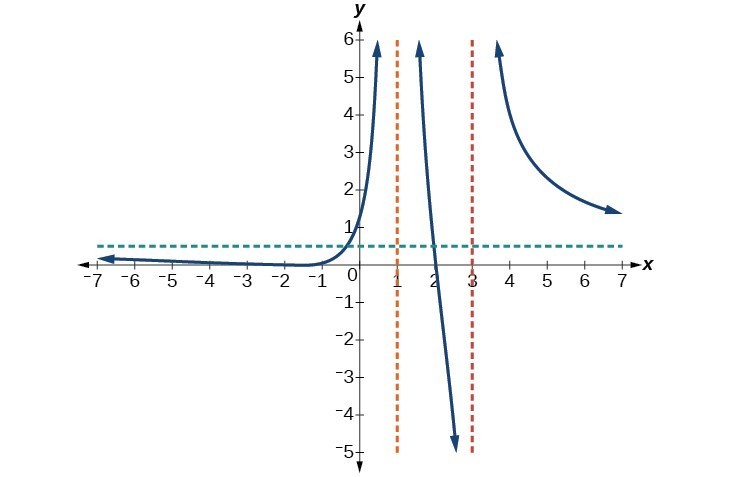Solutions to Try Its
1. End behavior: as [latex]x\to \pm \infty , f\left(x\right)\to 0[/latex]; Local behavior: as [latex]x\to 0, f\left(x\right)\to \infty[/latex] (there are no x– or y-intercepts)
2. The function and the asymptotes are shifted 3 units right and 4 units down. As [latex]x\to 3,f\left(x\right)\to \infty\\[/latex], and as [latex]x\to \pm \infty ,f\left(x\right)\to -4[/latex].
The function is [latex]f\left(x\right)=\frac{1}{{\left(x - 3\right)}^{2}}-4[/latex].

3. [latex]\frac{12}{11}[/latex]
4. The domain is all real numbers except [latex]x=1[/latex] and [latex]x=5[/latex].
5. Removable discontinuity at [latex]x=5[/latex]. Vertical asymptotes: [latex]x=0,\text{ }x=1[/latex].
6. Vertical asymptotes at [latex]x=2[/latex] and [latex]x=-3[/latex]; horizontal asymptote at [latex]y=4[/latex].
7. For the transformed reciprocal squared function, we find the rational form. [latex]f\left(x\right)=\frac{1}{{\left(x - 3\right)}^{2}}-4=\frac{1 - 4{\left(x - 3\right)}^{2}}{{\left(x - 3\right)}^{2}}=\frac{1 - 4\left({x}^{2}-6x+9\right)}{\left(x - 3\right)\left(x - 3\right)}=\frac{-4{x}^{2}+24x - 35}{{x}^{2}-6x+9}[/latex]
Because the numerator is the same degree as the denominator we know that as [latex]x\to \pm \infty , f\left(x\right)\to -4; \text{so } y=-4[/latex] is the horizontal asymptote. Next, we set the denominator equal to zero, and find that the vertical asymptote is [latex]x=3[/latex], because as [latex]x\to 3,f\left(x\right)\to \infty[/latex]. We then set the numerator equal to 0 and find the x-intercepts are at [latex]\left(2.5,0\right)[/latex] and [latex]\left(3.5,0\right)[/latex]. Finally, we evaluate the function at 0 and find the y-intercept to be at [latex]\left(0,\frac{-35}{9}\right)[/latex].
8. Horizontal asymptote at [latex]y=\frac{1}{2}[/latex]. Vertical asymptotes at [latex]x=1 \text{and} x=3[/latex]. y-intercept at [latex]\left(0,\frac{4}{3}.\right)[/latex]
x-intercepts at [latex]\left(2,0\right) \text{ and }\left(-2,0\right)[/latex]. [latex]\left(-2,0\right)[/latex] is a zero with multiplicity 2, and the graph bounces off the x-axis at this point. [latex]\left(2,0\right)[/latex] is a single zero and the graph crosses the axis at this point.

Solutions to Try Its
1. The rational function will be represented by a quotient of polynomial functions.
3. The numerator and denominator must have a common factor.
5. Yes. The numerator of the formula of the functions would have only complex roots and/or factors common to both the numerator and denominator.
7. [latex]\text{All reals }x\ne -1, 1[/latex]
9. [latex]\text{All reals }x\ne -1, -2, 1, 2[/latex]
11. V.A. at [latex]x=-\frac{2}{5}[/latex]; H.A. at [latex]y=0[/latex]; Domain is all reals [latex]x\ne -\frac{2}{5}[/latex]
13. V.A. at [latex]x=4, -9[/latex]; H.A. at [latex]y=0[/latex]; Domain is all reals [latex]x\ne 4, -9[/latex]
15. V.A. at [latex]x=0, 4, -4[/latex]; H.A. at [latex]y=0[/latex]; Domain is all reals [latex]x\ne 0,4, -4[/latex]
17. V.A. at [latex]x=-5[/latex]; H.A. at [latex]y=0[/latex]; Domain is all reals [latex]x\ne 5,-5[/latex]
19. V.A. at [latex]x=\frac{1}{3}[/latex]; H.A. at [latex]y=-\frac{2}{3}[/latex]; Domain is all reals [latex]x\ne \frac{1}{3}[/latex].
21. none
23. [latex]x\text{-intercepts none, }y\text{-intercept }\left(0,\frac{1}{4}\right)[/latex]
25. Local behavior: [latex]x\to -{\frac{1}{2}}^{+},f\left(x\right)\to -\infty ,x\to -{\frac{1}{2}}^{-},f\left(x\right)\to \infty[/latex]
End behavior: [latex]x\to \pm \infty ,f\left(x\right)\to \frac{1}{2}[/latex]
27. Local behavior: [latex]x\to {6}^{+},f\left(x\right)\to -\infty ,x\to {6}^{-},f\left(x\right)\to \infty[/latex], End behavior: [latex]x\to \pm \infty ,f\left(x\right)\to -2[/latex]
29. Local behavior: [latex]x\to -{\frac{1}{3}}^{+},f\left(x\right)\to \infty ,x\to -{\frac{1}{3}}^{-}[/latex], [latex]f\left(x\right)\to -\infty ,x\to {\frac{5}{2}}^{-},f\left(x\right)\to \infty ,x\to {\frac{5}{2}}^{+}[/latex] , [latex]f\left(x\right)\to -\infty[/latex]
End behavior: [latex]x\to \pm \infty\\[/latex], [latex]f\left(x\right)\to \frac{1}{3}[/latex]
31. [latex]y=2x+4[/latex]
33. [latex]y=2x[/latex]
35. [latex]V.A.\text{ }x=0,H.A.\text{ }y=2[/latex]

37. [latex]V.A.\text{ }x=2,\text{ }H.A.\text{ }y=0[/latex]

39. [latex]V.A.\text{ }x=-4,\text{ }H.A.\text{ }y=2;\left(\frac{3}{2},0\right);\left(0,-\frac{3}{4}\right)[/latex]

41. [latex]V.A.\text{ }x=2,\text{ }H.A.\text{ }y=0,\text{ }\left(0,1\right)[/latex]

43. [latex]V.A.\text{ }x=-4,\text{ }x=\frac{4}{3},\text{ }H.A.\text{ }y=1;\left(5,0\right);\left(-\frac{1}{3},0\right);\left(0,\frac{5}{16}\right)[/latex]
45. [latex]V.A.\text{ }x=-1,\text{ }H.A.\text{ }y=1;\left(-3,0\right);\left(0,3\right)[/latex]

47. [latex]V.A.\text{ }x=4,\text{ }S.A.\text{ }y=2x+9;\left(-1,0\right);\left(\frac{1}{2},0\right);\left(0,\frac{1}{4}\right)[/latex]

49. [latex]V.A.\text{ }x=-2,\text{ }x=4,\text{ }H.A.\text{ }y=1,\left(1,0\right);\left(5,0\right);\left(-3,0\right);\left(0,-\frac{15}{16}\right)[/latex]

51. [latex]y=50\frac{{x}^{2}-x - 2}{{x}^{2}-25}[/latex]
53. [latex]y=7\frac{{x}^{2}+2x - 24}{{x}^{2}+9x+20}[/latex]
55. [latex]y=\frac{1}{2}\frac{{x}^{2}-4x+4}{x+1}[/latex]
57. [latex]y=4\frac{x - 3}{{x}^{2}-x - 12}[/latex]
59. [latex]y=-9\frac{x - 2}{{x}^{2}-9}[/latex]
61. [latex]y=\frac{1}{3}\frac{{x}^{2}+x - 6}{x - 1}[/latex]
63. [latex]y=-6\frac{{\left(x - 1\right)}^{2}}{\left(x+3\right){\left(x - 2\right)}^{2}}[/latex]
65.
| x | 2.01 | 2.001 | 2.0001 | 1.99 | 1.999 |
| y | 100 | 1,000 | 10,000 | –100 | –1,000 |
| x | 10 | 100 | 1,000 | 10,000 | 100,000 |
| y | .125 | .0102 | .001 | .0001 | .00001 |
Vertical asymptote [latex]x=2[/latex], Horizontal asymptote [latex]y=0[/latex]
67.
| x | –4.1 | –4.01 | –4.001 | –3.99 | –3.999 |
| y | 82 | 802 | 8,002 | –798 | –7998 |
| x | 10 | 100 | 1,000 | 10,000 | 100,000 |
| y | 1.4286 | 1.9331 | 1.992 | 1.9992 | 1.999992 |
Vertical asymptote [latex]x=-4[/latex], Horizontal asymptote [latex]y=2[/latex]
69.
| x | –.9 | –.99 | –.999 | –1.1 | –1.01 |
| y | 81 | 9,801 | 998,001 | 121 | 10,201 |
| x | 10 | 100 | 1,000 | 10,000 | 100,000 |
| y | .82645 | .9803 | .998 | .9998 |
Vertical asymptote [latex]x=-1[/latex], Horizontal asymptote [latex]y=1[/latex]
71. [latex]\left(\frac{3}{2},\infty \right)[/latex]

73. [latex]\left(-2,1\right)\cup \left(4,\infty \right)[/latex]

75. [latex]\left(2,4\right)[/latex]
77. [latex]\left(2,5\right)[/latex]
79. [latex]\left(-1,\text{1}\right)[/latex]
81. [latex]C\left(t\right)=\frac{8+2t}{300+20t}[/latex]
83. After about 6.12 hours.
85. [latex]A\left(x\right)=50{x}^{2}+\frac{800}{x}[/latex]. 2 by 2 by 5 feet.
87. [latex]A\left(x\right)=\pi {x}^{2}+\frac{100}{x}[/latex]. Radius = 2.52 meters.
Candela Citations
- Precalculus. Authored by: Jay Abramson, et al.. Provided by: OpenStax. Located at: http://cnx.org/contents/fd53eae1-fa23-47c7-bb1b-972349835c3c@5.175. License: CC BY: Attribution. License Terms: Download For Free at : http://cnx.org/contents/fd53eae1-fa23-47c7-bb1b-972349835c3c@5.175.